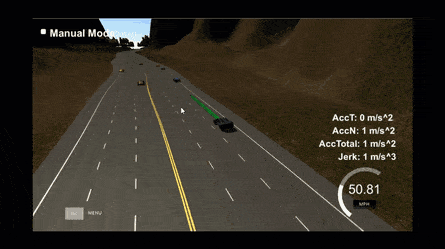05. Sensor Fusion
Sensor Fusion
It's important that the car doesn't crash into any of the other vehicles on the road, all of which are moving at different speeds around the speed limit and can change lanes.
The
sensor_fusion
variable contains all the information about the cars on the right-hand side of the road.
The data format for each car is: [ id, x, y, vx, vy, s, d]. The id is a unique identifier for that car. The x, y values are in global map coordinates, and the vx, vy values are the velocity components, also in reference to the global map. Finally s and d are the Frenet coordinates for that car.
The vx, vy values can be useful for predicting where the cars will be in the future. For instance, if you were to assume that the tracked car kept moving along the road, then its future predicted Frenet s value will be its current s value plus its (transformed) total velocity (m/s) multiplied by the time elapsed into the future (s).
Changing Lanes

Creating paths with smooth lane changes
The last consideration is how to create paths that can smoothly changes lanes. Any time the ego vehicle approaches a car in front of it that is moving slower than the speed limit, the ego vehicle should consider changing lanes.
The car should only change lanes if such a change would be safe, and also if the lane change would help it move through the flow of traffic better.
For safety, a lane change path should optimize the distance away from other traffic. For comfort, a lane change path should also result in low acceleration and jerk. The acceleration and jerk part can be solved from linear equations for s and d functions. Examples of this can be found in the Trajectory Generation quizzes entitled, "Quintic Polynomial Solver" and "Polynomial Trajectory".
The provided Eigen-3.3 library can solve such linear equations. The
getXY
helper function can transform (s,d) points to (x,y) points for the returned path.